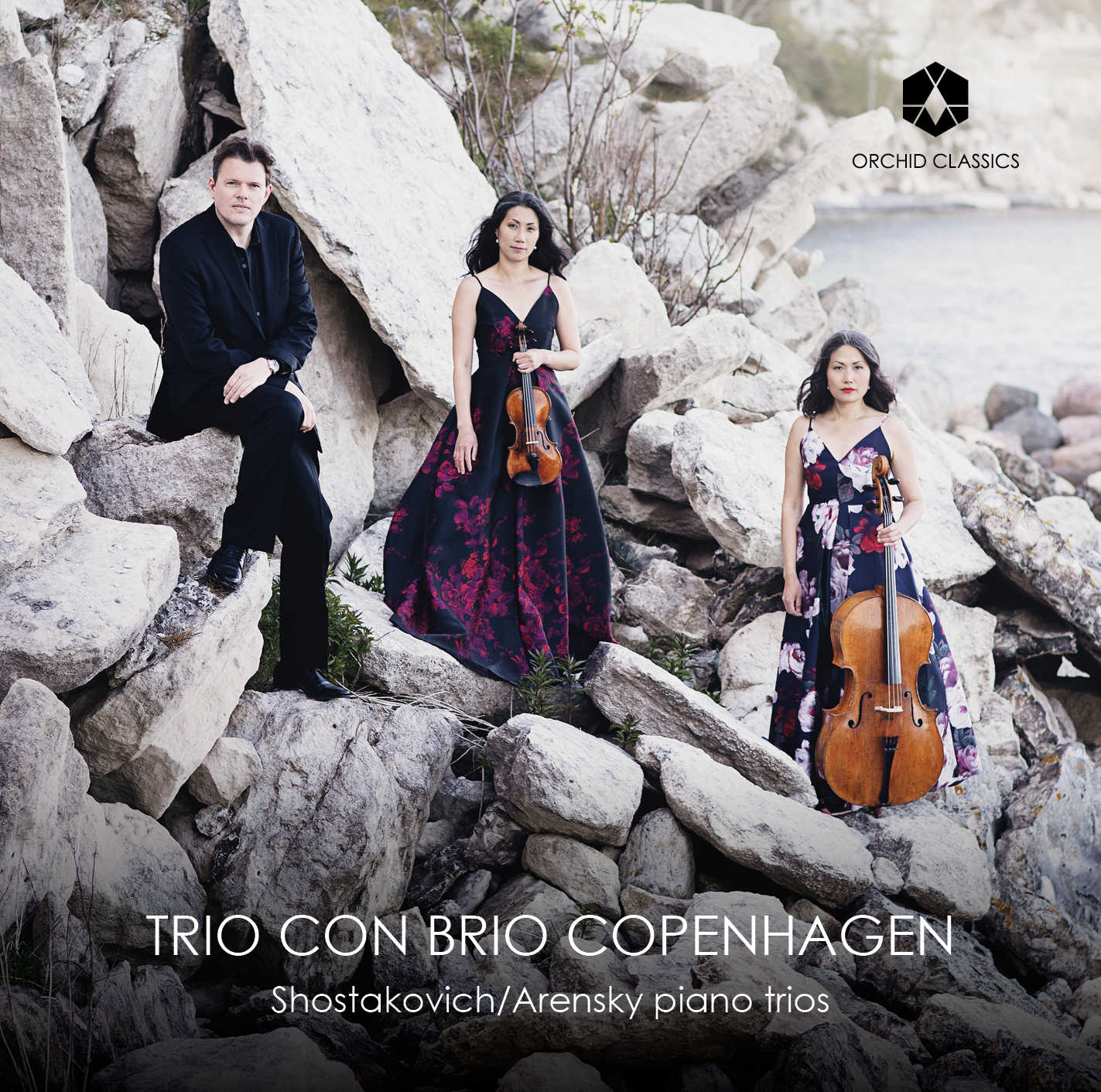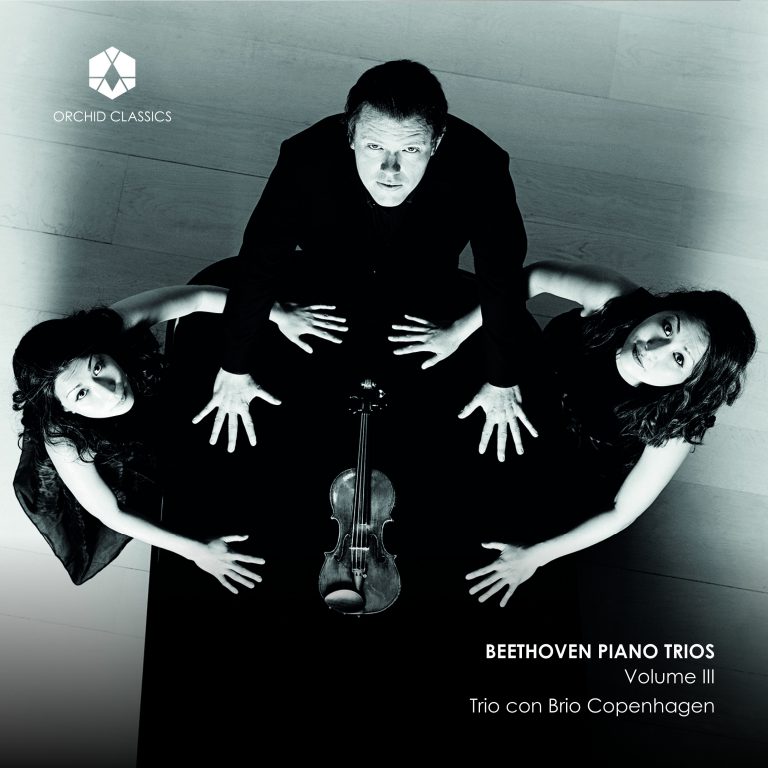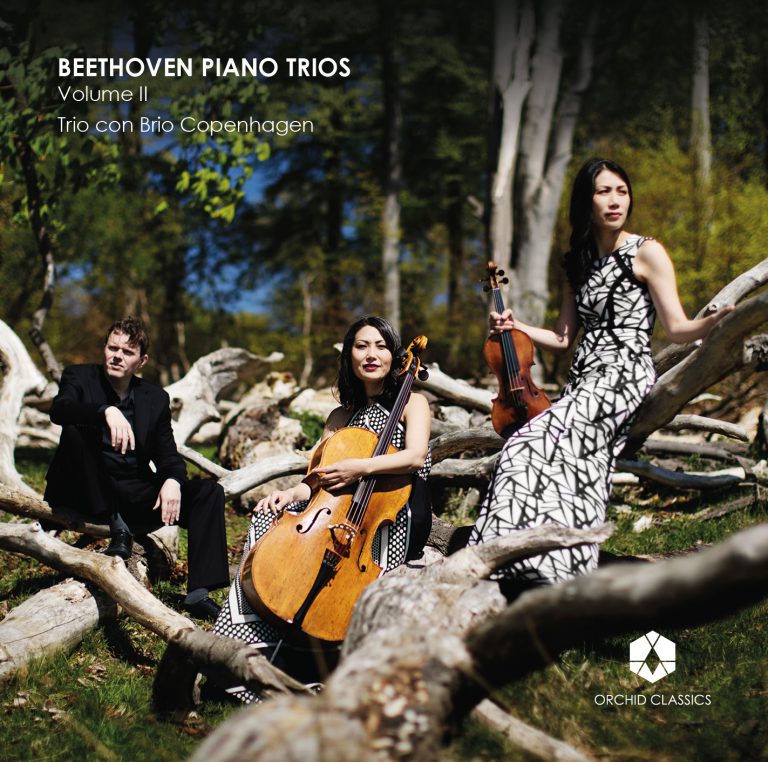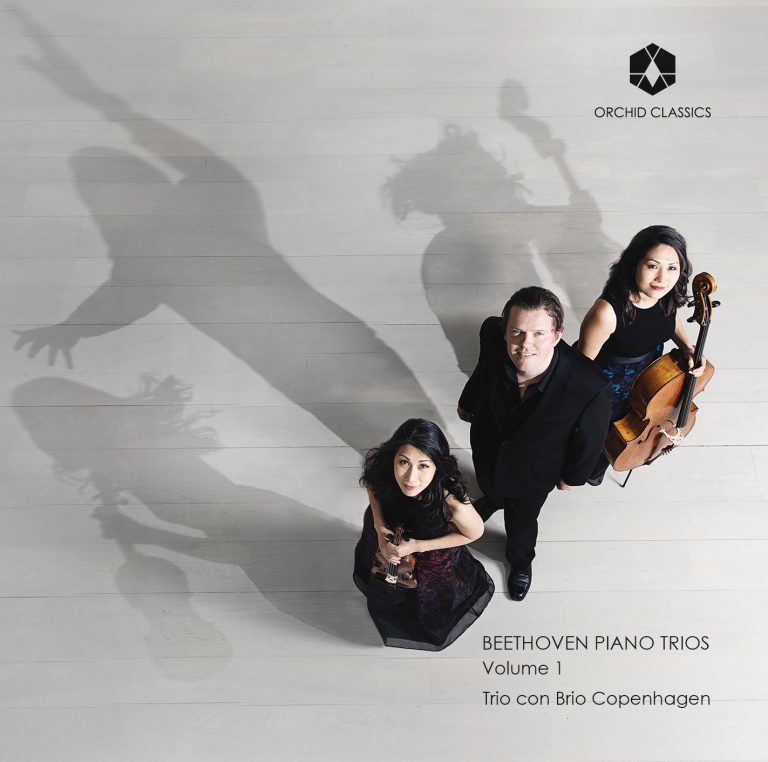Artist Led, Creatively Driven

Trio con Brio Copenhagen
Shostakovich & Arensky piano trios
Release Date: November 19th
ORC100181
Dmitri Shostakovich (1906-1975)
1. Piano Trio No.1 in C minor ‘Poème’, Op.8
Anton Arensky (1861-1906)
Piano Trio No.1 in D minor, Op.32
2. I Allegro moderato
3. II Scherzo. Allegro molto
4. III Elegia. Adagio
5. IV Finale. Allegro non troppo
Dmitri Shostakovich (1906-1975)
Piano Trio No.2 in E minor, Op.67
6. I Andante
7. II Allegro con brio
8. III Largo
9. IV Allegretto
Trio con Brio Copenhagen
Soo-Jin Hong, violin
Soo-Kyung Hong, cello
Jens Elvekjaer, piano
Music before and after a revolution
Despite the fact that Anton Arensky lived in the Tsarist period prior to the Russian revolution, and Dmitri Shostakovich in the communist Soviet Union which succeeded it, both are exponents of a vibrant Russian chamber music tradition, which displays a special love of singable melodies, pain and passion. We find this in its purest form in Arensky’s Piano Trio No.1 from 1894, when Romantic music – in the year after the death of Tchaikovsky – is at a peak in Russia.
In 1906, when Arensky dies and Shostakovich is born, the old world is beginning to crumble, and the hard-pressed Tsar loosens his dictatorial hold on the Russian people. But it is not until the revolution in 1917 that things seriously change. And when the 17-year-old Shostakovich writes his Piano Trio No.1 Poème in 1923 in Petrograd (St. Petersburg), he finds expression for strong personal emotions via a musical language that reminds one of the montage techniques which filmmakers of the time were experimenting with.
Just over twenty years later, in 1944, when Shostakovich writes his Piano Trio No.2, the age of experimentation is long since passed, and Shostakovich instead makes the music a medium for that which cannot and must not be expressed in words. By making use of Jewish music for the first time, Shostakovich succeeds in giving the greatest tragedies of the age a voice, while at the same time creating a music that displays an irrepressible spark of life.
Shostakovich’s Piano Trio No.1 originally had the title Poème and it was written to a young woman of the same age, Tatyana Glivenko, who Shostakovich falls in love with during a rest cure in the Crimea in summer 1923. His love is requited, and the couple continues to see each other for a great number of years, although Tatyana and Dmitri never married. Completely in accordance with the new ideals of the age, they are believers in free love, a form where one must not take the other person’s feelings as security. Nevertheless, Shostakovich is deeply hurt when Tatyana, six years later, marries another man.
The trio is in the fateful key of C minor, and, like Beethoven, Shostakovich presents a central musical theme from the very beginning, in the form of an agonised descending motif, played with great intensity on the cello. In this love music, love always means an aching heart, and everything is up for discussion. A short while after this, the music radically changes, and the melodious mood is replaced by teasingly jerky, disconnected music. As in the contemporary agitprop art which the young Soviet regime used to spread ideological messages, where the emphasis is on power of effect.
But Shostakovich’s intention is a different one. And when the music finally changes into a major key, with wonderful chiming sounds on the piano and a light, upward-striving theme, a world of feeling that is Russian through and through as well as the volatile sensitivity of a young mind are opened up. Precisely this theme is flung out by both violin and cello with immense expressiveness towards the end of the trio, where we are dealing with an invocation of the newly won love.
This, however, does not alter the picture of stormy music, characterised by sudden shifts and cuts, in which the sarcastic – later to become a central signature for Shostakovich – plays an important role.
And he is well aware of this himself. In a letter to his mother, Shostakovich refers to his teacher Maximilian Steinberg’s frustrated comment, “What sort of an obsession with the grotesque is this?”. This sort of music was not at all comme il faut at the conservative conservatoire in Petrograd, so Shostakovich applies to become a student at the conservatoire in Moscow, where Tatyana is living. After a performance there of Piano Trio No.1 he is warmly welcomed to the composition class there. Times change!
Anton Arensky is 43 years old and at the height of his career when he writes his Piano Trio No.1 in D minor in 1894 in Moscow. He is a professor at the conservatoire, where Rachmaninov is one of his pupils, and he has been in close contact with the recently deceased Tchaikovsky. It is nevertheless the cellist Karl Davydov, who used to be called ‘the tsar of the cellists’, whom Arensky is commemorating with his trio. This is particularly the case in the third movement, Elegy, where the cello, in a subdued tone, sings a wonderfully fervent melody. The music strives upwards, flows freely, and is characterised by a sadness that liberates the emotions.
Arensky, who while still a boy composed songs and who afterwards enjoyed great success with his opera A Dream on the Volga, has a masterly grasp of melodic line. This is clear from the very outset. The violin presents a theme in which the notes seem to cling to each other in the most natural way. With its growing intensity and animated pulse, the music is like a moving maelstrom. The effect is yet more powerful when the movement concludes with an Adagio and a longing look back to the initial soulful theme, which is now lifted aloft by the violin.
The second movement, Scherzo, makes a sophisticated use of overtones and, with a proudly strutting waltz, provides an insight into the Tsarist cultivation of a glittering dream world in its most charming form. In the finale, Arensky allows the three instruments to play with orchestral weight, and the pulse is once more intense until Arensky, with his keen sense of musical timing, makes time stand still. With delicate star-sparkling notes the piano now paints a beautiful backdrop for a reappearance of the elegiac themes from the first movement. And even though the music is finally whirled up into an Allegro molto, it only seems to resemble a gust of wind that draws attention to what has just taken place.
The fellow-composer Rimsky-Korsakov, who had also been Arensky’s teacher, wrote much later in life, after Arensky’s death at the age of 45, that he would soon be forgotten. That harsh judgment fortunately did not hold good. One good reason why Arensky’s Piano Trio No.1 continues to be played is probably that Arensky did not adhere to the then strongly national style praised by Rimsky-Korsakov. Arensky was influenced to a greater extent by the cosmopolitan Tchaikovsky’s sense of large symphonic drama, while remaining conscious of his own Russian roots. An aesthetic standpoint that Arensky himself described as “a dramatically self-assured music of lyrical beauty”.
In his Piano Trio No.2 in E minor, Shostakovich drops his masks to a rare degree. While working on the trio, he states in an interview in January 1944 that chamber music not only calls for an impeccable compositional technique but also depth of thought, for here it is impossible to hide oneself behind orchestral colours.
A few weeks later, Shostakovich’s closest friend, the musicologist and expert in Romance languages, Ivan Sollertinsky, suddenly dies, 41 years old, in a camp in Novosibirsk, after having been evacuated from besieged Leningrad. Shostakovich is distressed at the news, and when he has completed the trio just over six months later, he dedicates it to the memory of his dead friend who, like various other friends of his, was a Jew. During this period, there is growing antisemitism in the Soviet Union, and Shostakovich begins to glimpse the atrocities taking place in the Nazi concentration camps. His reaction is to incorporate Jewish music into the final weighty movement. This was not to be the last time he did so.
The course of all four movements is epic, like a novel or a film made up of violently emotional scenes charged with meaning. At the beginning of the trio the music steals in from unusual places. First, the cello in a whistling high, subdued register, and then the two other instruments, whispering in a low register. The content is the same. Inevitability is a condition here. And when the two string instruments introduce a monotonous knocking motif, Shostakovich plays his trump card, while the music becomes increasingly fierce. Now there is no way back. Towards the end of the movement the music dies away to the same silence out of which it was born. Eternity is also involved.
The second movement is a hysterical dance, brimful of absurd musical grimaces. Perhaps an image of a world twisted out of joint. Perhaps a spontaneous burst of absurd humour. Sollertinsky’s sister was convinced that it was a portrait of her brother. His temperament, his way of polemicising and speaking.
The third movement – a passacaglia – is a sepulchral monument built up of sombre piano chords which, with relentless insistence, rise-up like pillars that are rooted in hell. Above this, the two string instruments can be heard. A lament and a humanistic statement in a barren world which is transformed in the final movement into a ‘dance macabre’. Initially restrained, but soon the skeletons tumble out of the cupboard, while an unstoppable Jewish dance tune causes the musical foundation to glow and changing time signatures makes time start to dissolve. We are witnessing a never-ending drama, a painful celebration of Jewish culture, where the music alternately retreats, forbiddingly underplayed like a sleepwalker, and then increases in strength, right up to the bone.
Not even a cascade of notes that come from the piano like a dense snowstorm can halt the advance of the music. Only now it is only heard through a veil, and when we finally, via frail notes from the cello, are reminded of the opening theme, it is as if the music can start all over again at any time.
Later, in a conversation with the Russian Jewish poet Aron Vergelis, Shostakovich described his interest in Jewish music by precisely its dual nature: “A cheerful melody builds here on sad intonations… It is as if ‘the Jewish people’ is present
in the single individual… Why does he sing a cheerful song? Because he is sad at heart.”
© Trio con Brio Copenhagen & Esben Tange
Trio con Brio Copenhagen
”Trio con brio de copenhague: formation d’élite… We can now see the Con Brio as the worthy successors of the legendary Beaux-Arts Trio. That says it all!”
Diapason
Acknowledged as one of the finest piano trios in the world, the Trio con Brio Copenhagen is about to enter their 23rd season. Founded at the University of Music and Performing Arts in Vienna in 1999, the Trio is now based in Copenhagen and tours extensively worldwide.
The Trio was born out of an idea of the coming together of ‘musical pairs’ – of the two Korean-born sisters, Soo-Kyung Hong (cello) and Soo-Jin Hong (violin), with Soo-Kyung and her husband, Danish pianist Jens Elvekjaer. They quickly gained a reputation for their fresh and contemporary approach to the core repertoire. “Works by Beethoven, Schubert and Brahms are transformed in their hands into the alive-and-kicking music of today” said Danish Broadcasting’s Esben Tange. Winning almost all of the major competitions for piano trio – including the ARD (Munich), Vittorio Gui (Florence), Trondheim Competition (Norway), Kalichstein-Laredo-Robinson (USA), Allianz Prize (Germany) and receiving the prestigious “P2 Artists Prize” and “Carl Nielsen and Anne Marie Carl-Nielsen’s Honorary Award” (Denmark) – they are regularly heard at the world’s leading venues and concert series. Among these, Carnegie Hall, Lincoln Center, Wigmore Hall, Berlin Pierre Boulez-Saal, Concertgebouw, Elbphilharmonie Hamburg, Seoul Arts Centre, Théâtre de la Ville Paris and of course their beloved “home venues”, the Royal Library, DR Koncerthuset and the Tivoli Concert Hall, in Copenhagen.
Trio con Brio Copenhagen plays a central role in Scandinavia’s vibrant contemporary music scene. Leading composers have dedicated works to the Trio. They were enormously honoured that Per Nørgård dedicated to them a new piece celebrating his 80th birthday in 2012. In January 2016 the Trio presented the world premiere of Bent Sørensen’s Triple Concerto with the Danish National Symphony Orchestra, a work that won the prestigious Grawemeyer Award. Furthermore, they premiered Sven-David Sandström’s Triple Concerto, a work that marks his 70th birthday.
Reviews are fulsome. “One of the greatest performances of chamber music I’ve ever encountered,” praised American Record Guide. Gramophone wrote, “Superb…Any group would be hard-pressed to imitate this blend of verve and poise…”. Their Mendelssohn album was chosen by the UK’s Classic FM as the Best Chamber Music Disc of the year: “Every phrase soars and pulsates with the excitement of a fresh discovery as the Copenhagen players go the full distance with playing of skin-rippling sensitivity… sensational playing…”. Their Tchaikovsky and Smetana recording was hailed by The Guardian, “… Trio con Brio Copenhagen scale Tchaikovsky’s heights with the verve their name suggests …” The Trio’s most recent recordings of the complete Beethoven piano trios were received with the highest critical acclaim, with comments such as “… I was struck… by the feeling of improvisation; of three players moving forward together into a strange and wonderful new world…” (Gramophone).
The Trio are artistic directors of the Copenhagen Chamber Music Festival, the Chamber Music at Lundsgaard in Kerteminde and the Hellerup Chamber Music Society in Copenhagen. Soo-Jin plays an Andrea Guarneri violin, Soo-Kyung plays a Grancino cello, and Jens is Denmark’s first Steinway Artist. Both string players are endorsed by Jargar Strings and Thomastik-Infeld Vienna.
All three members of the trio knew right from the start that they would find their musical identities as a piano trio: “There is something about the configuration of a trio, about that triangle, that somehow focuses and amplifies the special understanding that we all have as people and as musicians. It is both a freedom and a fulfillment.”










